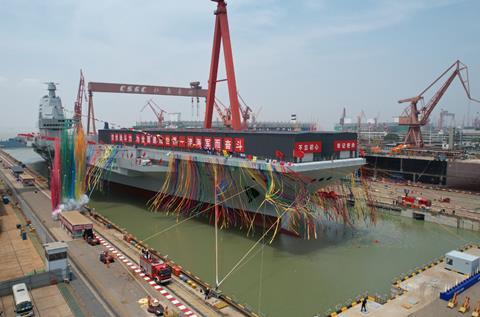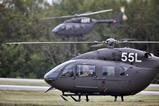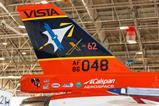In its annual report on the state of Chinese military power, the US Department of Defense says Beijing’s air force has made significant advances and is “quickly approaching US standards” in some key areas.
Released on 18 December, the report says Beijing is continuing to develop the People’s Liberation Army (PLA) into an “increasingly capable instrument of national power” through the development of military capabilities needed to “fight and win wars” against a “strong enemy”, while also projecting power and influence globally.
Notably, the Pentagon concludes that the PLA air force (PLAAF) is rapidly closing the gap with its American counterpart in critical areas, such as the production and fielding on unmanned aerial systems (UAS).
“With respect to its modernisation and indigenisation of its unmanned aerial systems, [the PLAAF] is quickly approaching US standards,” a senior US defence official said on 16 December.
The individual spoke to members of the media on the condition of anonymity ahead of the report’s release.

The Pentagon says increasingly sophisticated Chinese UAS now make routine appearances at high-level theatre commands. By contrast, the US military regularly deploys such systems at the tactical level.
Despite that disparity, the past three years have seen what the Pentagon describes as key milestones in Chinese UAS development. These include the operational deployment of the Guizhou WZ-7 high-altitude long-endurance jet, the unveiling of the supersonic AVIC WZ-8 air-launched strike-reconnaissance platform and a redesigned version of the Shenyang-Hongdu GJ-11, which the Pentagon describes as a stealth unmanned combat air vehicle.
A previous version of the GJ-11 featured two internal weapons bays, each capable of carrying four glide bombs. Although it has made few public appearances, the “Sharp Sword” was carried by truck in a 2019 military parade and displayed at the 2021 Zhuhai air show.
It has been speculated the tail-less flying-wing type will be paired with the two-seat version of the Chengdu J-20 fighter.

At the 2024 Zhuhai air show in November, Chinese state-owned aerospace corporation AVIC debuted several new uncrewed aircraft, including the Nine Sky strike and reconnaissance jet and the multi-role Jetank platform – noted for its “swarm carrier” capability to deploy dozens of small drones from a hive module.
Several conventional fighters also broke cover, including the carrier-capable Shenyang J-15T and Shenyang J-35A – a twin-engined, fifth-generation-style jet that bears a strong visual resemblance to the Lockheed Martin F-35.
“Air and trade shows are displaying growing numbers of autonomous and teaming systems, including for combat applications,” the Pentagon report says.
Notably, China has demonstrated an interest in expanding its UAS capability beyond traditional functions such as reconnaissance and electronic warfare into more complex areas like air-to-air and air-to-ground combat.

Deployment of such systems has become a major focus for both the US Air Force and US Army over the past two years. The air force has rolled out its Collaborative Combat Aircraft (CCA) initiative to produce an autonomous fighter jet, while the army is testing a suite of new drones to support its ground combat forces.
The air force is testing two finalists for its first-generation CCA, with UAV makers General Atomics Aeronautical Systems and Anduril competing.
“Substantial development efforts to produce swarming capability for operational applications”, are underway within the PLA, according to the Pentagon. These systems are focused around identifying and destroying penetrating threats targeting anti-air assets.
The PLAAF and PLA navy (PLAN) together represent the largest aviation force in the Western Pacific, the Pentagon notes, and the third largest in the world. The combined force boasts over 3,150 total aircraft, not including trainers or UAS, with approximately 2,400 of those being combat fighters, bombers or attack aircraft.
China’s domestic aviation industry also continues to advance, with the Pentagon noting continued deliveries of the Xian Y-20 strategic airlifter and completion of the world’s largest seaplane in the AVIC AG600.
“These transports will supplement and eventually replace the PLA’s small fleet of strategic airlift assets, which to date consists of a limited number of Russian-made [Ilyushin] Il-76 aircraft,” the Pentagon says.
The USA is in the early stages of developing a heavy-lift amphibian, known as the Liberty Lifter, although its future is uncertain.

Production and deliveries of the Shaanxi KJ-500 airborne early warning and control aircraft also have continued at a “rapid pace”, according to the report, with at least one recent example featuring an aerial refuelling probe for extended range and endurance.
In the realm of naval aviation, the report notes that China’s third aircraft carrier, CNS Fujian, is expected to enter operational service in 2025 after sea trials this year. That ship is China’s first carrier to feature an electromagnetic catapult for launching aircraft, similar to the US Navy’s latest Ford-class carriers.
The Pentagon notes the PLAN is growing its capability to operate beyond the first island chain of Japan, Taiwan and the Philippines through increasing use of aircraft carriers and helicopter amphibious assault ships.
The Type 076 Yulan assault ship is projected to join the PLAN fleet in the second half of this decade, featuring catapult-launched UAS.
When asked if the PLAN is already able to conduct carrier operations as far out as Hawaii or the US West Coast, the senior defence official declined to address specifics, but notes that China has endeavoured to increase the navy’s long-distance sea training.

However, the findings were not entirely favourable toward Beijing.
State-owned media continue to highlight perceived shortcomings with the PLA’s commanders and personnel, the senior US defence official notes, while also lacking in key areas that would be critical to success in a regional conflict, such as long-range logistics and urban warfare.
The report also highlights what the senior official calls “severe corruption challenges” within the PLA over the preceding year.
“At least 15 high-ranking Chinese military officials and defence industry executives were removed from their posts for corruption,” the US official says, noting several were overseeing projects related to modernising China’s conventional and nuclear missile forces.
These include former defence minister Li Shangfu, who was removed in October 2023.
According to official Chinese Communist Party statements, Beijing has a current target of 2035 for completing its military modernisations.
Chinese state media, citing anonymous military and government sources, have identified an interim 2027 goal of deploying capabilities that can counter the US military in the Indo-Pacific region.
The 2027 target includes a secondary aim of being able to “compel Taiwan’s leadership to the negotiation table on the terms [of Beijing]”, the Pentagon claims.





























